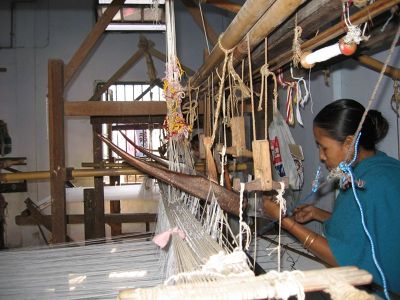Pat Silk or Paat Silk
Pat Silk (also known as Paat Silk) originates from Assam – where silk producing industry is established for three major silks of the east – Muga Silk, Pat Silk and Eri Silk. Usually comes in brilliant white or off-white shades, Pat Silk fabric is derived from Mulberry Silkworms and is known for its distinctive brightness, high quality and durable nature, hence also known as Mulberry Silk.
History
In 1946, when Mahatma Gandhi visited Sualkuchi, a designer Rajen Deka created a weave of Gandhi’s portrait on a piece of pat cloth and presented to him. The weave and design were done with such detailing that even the two broken front teeth of Gandhiji with a smiling face were depicted. It was then predicted that Pat silk will be one of the dream-weave of India.
Sources of Inspiration
Although Pat sarees are available in various bright colors, it was originally woven in shades of white. The Pat sarees are inspired by nature with their traditional motifs that include flower prints, human figurines, animal motifs, flowers, creepers and ornamental motifs. However,the designs and patterns vary from tribe to tribe. The motifs usually embellish the sari around the border and in the middle.
The Making of Pat Silk
Pat Silk is produced from Silkworms that are grown on mulberry bushes and hence the Silk is also known as Mulberry Silk. The fabric is primarily used for local consumption. However, the sericulture and Silk weaving community of commercial weavers buy 25 thousand kilograms of twisted mulberry Silk from the southern state of Karnataka in order to produce Pat sarees for clients outside Assam and abroad. Although the Mulberry Silk is light in weight and appears to be delicate, it is very durable in nature.
Style & Variety
In Assam, Pat is mainly used to make traditional dresses such as Mekhela Chador ( a wedding attire of the east), Dhoti and Saree wrapper. Hence, another limiting factor is the fact that the Pat handloom products have a very limited range as the industry has not adopted contemporary styles and apparel.
Innovations
There are a lot of attempts being made at giving a modern twist to the traditional Assamese Pat by giving it a new modern outlook and using Pat in various contemporary attires. However, presently, Pat is available in the form of Sarees, Suits and Lehengas within India and is also exported abroad. Soon Pat would be seen in more contemporary styles such as kurtis, purses, upholstery and so on, which would add more diversity to this beautiful handloom fabric.
Wearing the Attire
Pat Silk is mainly used in Assam for creating the wedding attire called Mekhela Chador which is a two-piece garment in cream or white that is embellished with silver and gold threads. However, Pat sarees in vibrant colors are also very commonly worn in Assam.
With the upcoming options of scarves and jackets for giving a traditional look to any western outfit, there would be more Pat Silk accessory options in due course of time that would render Pat to be a popular fabric amongst the present generation.
Global Appeal
Although Pat sarees are gaining a good reputation across the country and abroad, the weavers are still not projecting and marketing their Pat products in a bid to create more popularity for their handloom product and increase the sales.
Sarees are perhaps the most widely sold Pat handloom products due to their sheer color combination,sheen and durability. They are suitable for all ages and Pat sarees are considered to be superior Silk sarees. The saree is handwoven by adept weavers and hence, they have a very wide appeal for those who admire the craftsmanship. They last longer and can be worn in any season as Pat Silk is very skin friendly due to its organic composition.
Maintenance
Pat Silk is very durable, although on the outlook it might seem very delicate and lightweight. However, as is the case with most Silks, Pat sarees or any garment made out of Pat Silk should be dry cleaned and kept wrapped in a cloth. It should be taken out from time to time to check for any damage.
Interesting Facts and Comparisons
- Pat Silk is also known as Mulberry Silk.
- Due to thousands of years of being in captive breeding, mulberry worms cannot survive without human care and feeding.
- 178 pounds of cocoons reared in one acre of land eventually translates into 35 pounds of Pat Silk.
Reference
Categories: Textiles

